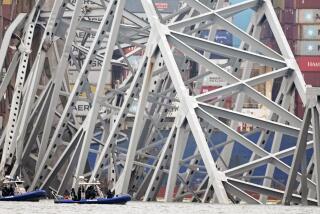Not Just for Kids: ‘Titanic: Voices From the Disaster’
Titanic
Voices From the Disaster
Deborah Hopkinson
Scholastic: 304 pp., $17.99, ages 8 and up
Few tragedies have captivated generations like the Titanic. There’s something about the disaster’s enormity and unlikeliness, coupled with the hubris that brought it about and the horrors that came afterward, that have made the Titanic a subject of enduring fascination even 100 years since it sunk in April 1912, killing 1,496 of the 2,208 people aboard.
With the centennial of the Titanic’s sinking approaching as surely as the iceberg that doomed the luxury liner on that chilly night, dozens of books are being released to commemorate it, including a nonfiction title for young readers from award-winning author Deborah Hopkinson. “Titanic: Voices From the Disaster” is exactly as its title indicates. It’s a meticulous recounting of the disaster culled from the accounts of survivors and witnesses, amply illustrated with black-and-white photos, handwritten ship’s logs, letters, menus and ice warnings sent from other ships that bring this eerie story to life in a way that words alone cannot. Though written for readers as young as 8, Hopkinson’s reporting is so rich with information that it will be equally fascinating to young readers and adults alike.
Hopkinson opens the book with a succession of photos that help readers visualize the people onboard and the epic proportions of the ship that was believed to be unsinkable and was, at the time, the largest ever built. Many of the pictures were taken by an amateur photographer named Frank Browne, who traveled aboard the Titanic from London to Queenstown, Ireland, but disembarked before it ventured out into the Atlantic. It’s haunting to see pictures of the actual people aboard, knowing what awaited them just a few days later.
Hopkinson underscores the Titanic’s largeness with interesting tidbits about its layout and cargo as well as introductions to many of its key players, including the so-called millionaires’ captain Edward James Smith, wireless operator Harold Bride, stewardess Violet Jessop and dozens of passengers who were lucky enough to escape in a lifeboat.
The morning before the ship’s sinking, Hopkinson slows the action. She quotes various passengers describing what they were doing and feeling in the hours leading to the boat’s impact. Whether they were innocently strolling the decks, swimming in the pool, attending church, reading books in the library or singing around the piano in a dining hall, many of them remarked on the chill air, but none was privy to the many, behind-the-scenes ice warnings that failed to reach the captain during the same time frame.
As night falls and the ship hits the iceberg (a photo of which is used as one of the book’s many pictorial illustrations), Hopkinson slows the action even further, giving multiple passenger accounts of the impact and their reactions, which progressed from curiosity to chaos once it became clear the ship was taking on water and beginning to tilt.
Hopkinson is a seasoned researcher and author of numerous nonfiction chronicles of the American experience. Her award-winning books include “Shutting Out the Sky: Life in the Tenements of New York, 1880-1924” and “Up Before Daybreak: Cotton and People in America.” She brings the same meticulous detail to “Titanic,” presenting the story in a suspenseful manner that will be easily understood by her intended audience.
Although the many individuals she includes are difficult to keep straight, each one’s experience helps to flesh out the unfolding nightmare. Children are sure to relate to the many scenes of women and children being separated from husbands and fathers and to react even more viscerally to scenes reported from the water. One survivor described the ship’s sinking as sounding “like standing under a steel railway bridge while an express train passes overhead, mingled with the noise of a pressed steel factory and the wholesale breakage of china.” Even worse were the moans of those who perished in the water.
Hopkinson sees the narrative through to passengers’ rescue by the Carpathia and the government hearings that led to safety standards still in place today, including sufficient lifeboats and safety drills. The book is anchored with photos of the sunken ship and detailed biographies of the book’s characters as well as letters, facts and figures.
Much as the Titanic itself is a chilling symbol of overconfidence and complacency, “Titanic: Voices From the Disaster” is a compelling investigation that reveals the many facets of human nature as a horrific tragedy was faced.
More to Read
The biggest entertainment stories
Get our big stories about Hollywood, film, television, music, arts, culture and more right in your inbox as soon as they publish.
You may occasionally receive promotional content from the Los Angeles Times.





